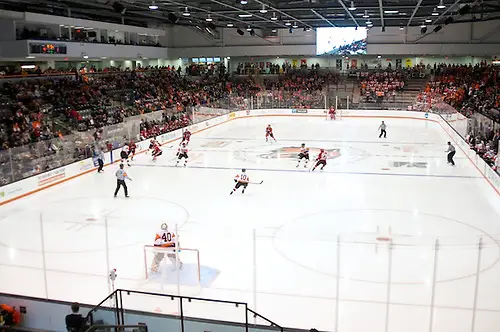
ROCHESTER, N.Y. — Countless dreams and four years of hard work have finally come to fruition at Rochester Institute of Technology.
On Sept. 18, the school dedicated the new $38 million Gene Polisseni Center, a 4,000-seat venue for the men’s and women’s hockey teams.
“The Polisseni Center symbolizes the growth of RIT hockey from the D-II and D-III days through Division I and the Frozen Four,” said RIT president Bill Destler. “It is a reflection of the commitment that RIT has to the community and the community has to RIT.”
RIT’s men’s and women’s hockey teams moved in to the new ice rink in September after playing at Frank Ritter Ice Arena for 46 years. While Ritter Arena was much-loved for its raucous atmosphere and close-to-the-action feel, its limited amenities and seating capacity became more obvious after the men’s team elevated to Division I in 2005.
Tickets became increasingly hard to come by, general admission bench seating turned families away, and the amenities of the rink were outdated.
The RIT men’s team’s run to the 2010 Frozen Four provided the impetus for dreams of a new rink to transform into action. In the fall of 2011, Steve and Vicki Schultz kicked off the effort with a large donation.
The RIT women’s hockey team winning the Division III national championship in 2012, its final season before moving to Division I, added momentum to the drive for a new facility.
Fundraising of all sorts followed, ground was broken in the summer of 2012, and the doors finally opened for the first game on Sept. 29.

Fan experience and maintaining the loud atmosphere that RIT hockey games are known for were important design considerations.
Reserved chair-back seating fills about three quarters of the Polisseni Center, with the remainder of the 4,000 seats set aside for general admission sections that include the infamous Corner Crew, students and pep band.
Reserved seating has proven popular with alumni, staff and the community, alleviating the need to arrive at games early to ensure a seat.
“Reserved seating is the best,” said alumnus Tom Naeger. “I can now stand in the Corner Crew while my wife and child have seats guaranteed.”
Another popular feature is the club section, which includes seating at center ice and provides fans a dinner buffet, lounge area, cash bar and other amenities during games.
Six luxury suites are spread throughout the venue for larger groups. They include an ice-level “bunker” suite and a VIP “player experience” box located as an extension of the home team bench.
The Polisseni Center centralizes the facilities used by the teams and support staff as well. The men’s and women’s hockey teams each have large locker and dressing rooms adjacent to a shared training room, along with weight rooms, team and video rooms, coaches offices and equipment rooms.
There are four visiting locker rooms as well as rooms for referees and other game officials.
“For the team, it is nice to have everything in one place,” said RIT volunteer assistant coach Mike Germain. “At Ritter, we had to go all over the complex for different things; now it is all right here.”

A large press box with individual broadcast booths unites television, radio, video and print media with the sports information staff for the first time, providing more cohesive coverage for games.
Instead of the more conventional center-ice scoreboard, the Polisseni Center includes two large video boards, one on each end of the arena, as well as smaller scoreboards on the walls near center ice that include timing, score and penalty information.
It gives everyone an unobstructed view of the entire arena and allows for concerts, graduation and other events to be held in the building after hockey season concludes.
While there are growing pains with any new facility, the teams and the fans are both striving to make the Polisseni Center the new home of RIT hockey.
“I miss the Ritter but they made it real easy to like the new rink,” said RIT alumnus Paul Meyerhofer. “It just feels right.”


